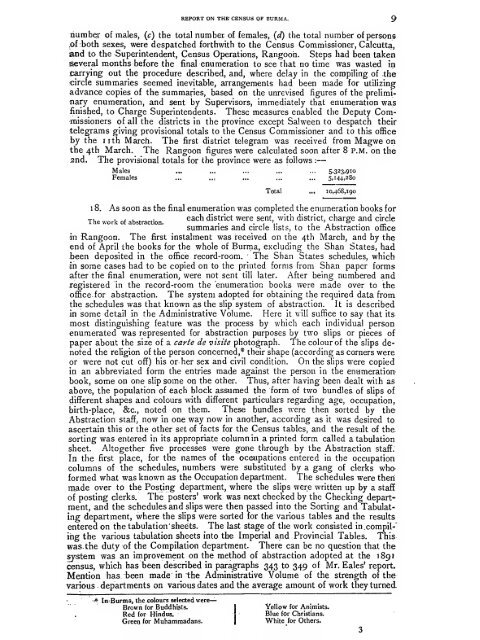Burma: Census of India 1901 Vol. I - Khamkoo
Burma: Census of India 1901 Vol. I - Khamkoo
Burma: Census of India 1901 Vol. I - Khamkoo
Create successful ePaper yourself
Turn your PDF publications into a flip-book with our unique Google optimized e-Paper software.
—<br />
REPORT ON THECENSUS OF BURMA.<br />
number <strong>of</strong> males, (c) the total number <strong>of</strong> females, (d) the total number <strong>of</strong> persons<br />
,<strong>of</strong> both sexes, were despatched forthwith to the <strong>Census</strong> Commissioner, Calcutta,<br />
and to the Superintendent, <strong>Census</strong> Operations, Rangoon. Steps had been taken<br />
several months before the final enumeration to see that no time was wasted in<br />
carrying out the procedure described, and, where delay in the compiling <strong>of</strong> the<br />
circle summaries seemed inevitable, arrangements had been made for utilizing<br />
advance copies <strong>of</strong> the summaries, based on the unrevised figures <strong>of</strong> the preliminary<br />
enumeration, and sent by Supervisors, immediately that enumeration was<br />
finished, to Charge Superintendents. These measures enabled the Deputy Commissioners<br />
<strong>of</strong> all the districts in the province except Salween to despatch their<br />
telegrams giving provisional totals to the <strong>Census</strong> Commissioner and to this <strong>of</strong>fice<br />
by the nth March. The first district telegram was received from Magwe on<br />
the 4th March. The Rangoon figures were calculated soon after 8 p.m. on the<br />
2nd. The provisional totals for the province were as follows:<br />
Males<br />
Females<br />
5,323,910<br />
5,144,280<br />
Total<br />
10,468,190<br />
18. As soon as the final enumeration was completed the enumeration books for<br />
The<br />
each district were sent, with district, charge and circle<br />
work <strong>of</strong> abstraction.<br />
summaries and circle lists, to the Abstraction <strong>of</strong>fice<br />
in Rangoon. The first instalment was received on the 4th March, and by the<br />
end <strong>of</strong> April the books for the whole <strong>of</strong> <strong>Burma</strong>, excluding the Shan States, had<br />
been deposited in the <strong>of</strong>fice record-room. The Shan States schedules, which<br />
'<br />
in some cases had to be copied on to the printed forms from Shan paper forms<br />
after the final enumeration, were not sent till later. After being numbered and<br />
.registered in the record-room the enumeration books were made over to the<br />
<strong>of</strong>fice. for abstraction. The system adopted for obtaining the required data from<br />
the schedules was that known as the slip system <strong>of</strong> abstraction. It is described<br />
in some detail in the Administrative <strong>Vol</strong>ume. Here it will suffice to say that its<br />
most distinguishing feature was the process by which each individual person<br />
enumerated was represented for abstraction purposes by two slips or pieces <strong>of</strong><br />
paper about the size <strong>of</strong> a carte de visite photograph. The colour <strong>of</strong> the slips denoted<br />
the religion <strong>of</strong> the person concerned,* their shape (according as corners were<br />
or were not cut <strong>of</strong>f) his or her sex and civil condition. On the slips were copied<br />
in an abbreviated form the entries made against the person in the enumeration<br />
book, some on one slip some on the other. Thus, after having been dealt with as<br />
above, the population <strong>of</strong> each block assumed the form <strong>of</strong> two bundles, <strong>of</strong> slips <strong>of</strong><br />
different shapes and colours with different particulars regarding age, occupation,<br />
birth-place, &c, noted on them. These bundles were then sorted by the<br />
Abstraction staff, now in one way now in another, according as it was desired to<br />
ascertain this or the other set <strong>of</strong> facts for the <strong>Census</strong> tables, and the result <strong>of</strong> the.<br />
sorting was entered in its appropriate column in a printed form called a tabulation<br />
sheet. Altogether five processes were gone through by the Abstraction staff.<br />
In the first place, for the names <strong>of</strong> the occupations entered in the occupation<br />
columns <strong>of</strong> the schedules, numbers were substituted by a gang <strong>of</strong> clerks who<br />
formed what was known as the Occupation department. The schedules were then<br />
made over to the Posting department, where the slips were written up by a staff<br />
<strong>of</strong> posting clerks. The posters' work was next checked by the Checking department,<br />
and the schedules and slips were then passed into the Sorting and Tabulating<br />
department, where the slips were sorted for the various tables and the results<br />
entered on the tabulation sheets. The last stage <strong>of</strong> the work consisted in.compil-"<br />
ihg the various tabulation sheets into the Imperial and Provincial Tables. This<br />
was. the duty <strong>of</strong> the Compilation department. There can be no question that the<br />
system was an improvement on the method <strong>of</strong> abstraction adopted at the 1891<br />
census, which has been described in paragraphs 343 to 349 <strong>of</strong> Mr. Eales' report.<br />
Mention has been made in the Administrative <strong>Vol</strong>ume <strong>of</strong> the strength or the<br />
various departments on various dates and the average amount <strong>of</strong> work they turned<br />
-*. Inr<strong>Burma</strong>, the.colours selected were—<br />
Brown for Buddhists.<br />
Red for Hindus.<br />
Green for Muhammadans.<br />
Yellow for Animists.<br />
Blue for Christians.<br />
White for Others.

















